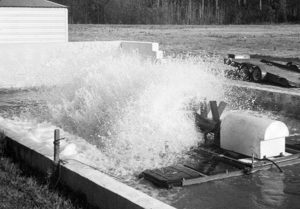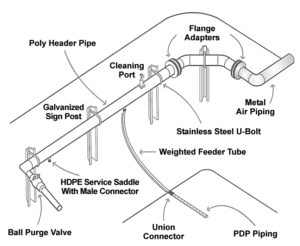
Overview of mechanical pond aeration
Mechanical pond aerators increase the rate at which oxygen from air enters water by providing a greater surface area to facilitate diffusion.
Sedimentation increases organic matter concentration in pond bottom soil. Particles originating from mineral soil and organic matter that do not float or dissolve settle to the bottom.

Mechanical pond aerators increase the rate at which oxygen from air enters water by providing a greater surface area to facilitate diffusion.

Integrated cage-cum-pond systems are high-value species are stocked in cages suspended in ponds with filter-feeding species stocked in open water.

Feeding allows much greater production of fish and shrimp, but nutrients in feed are not converted completely to fish or shrimp flesh.

For shrimp growers committed to using mechanical aeration and intensive culture densities, electrical power consumption is a major cost.

The authors integrated a vegetated filter strip into a commercial catfish pond to capture effluent as part of best management practices.

Probiotics used as bottom soil and water quality enhancers are primarily cultures of living bacteria, enzyme preparations, or the two combined.

Authors are developing a freshwater hatchery effluent bioremediation system that uses seaweed polyculture to decrease discharge levels and reduce remediation costs.

In aquaculture, foam fractionation involves the use of a protein skimmer to remove dissolved organic compounds from aquaculture systems.

Researchers are evaluating whether off-the-shelf flat-plate solar collectors can maintain stable recirculating aquaculture system temperatures.

A properly designed fluidized-bed filtration system increases hatchery output by providing a chemically stable, high-quality water supply.

Because of the high prices paid for live reef fish, overfishing of species such as groupers and Napoleon wrasse is a common problem throughout their range.

It would be difficult to find a pond aquaculture worker who has not measured Secchi disk visibility or at least seen someone measure it.

In pond culture, the application of formulated feed – some with very high protein content of 30-60 percent – constitutes the main nutrient input.

Phosphorus is one of the most scrutinized nutrients discharged by aquaculture systems, due to its potential eutrifying impact on receiving bodies of water.

Since 1985, white shrimp farming has developed significantly in northwestern Mexico along the coastal lagoons of the states of Nayarit, Sonora, and Sinaloa.